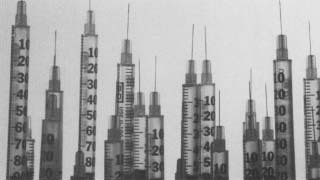Syringe
The syringe is a pump-like device used to inject or remove liquids by suction. It consists of a tube that is tapered at one end and has a plunger at the other end. When the plunger is pulled back, it creates suction. When pushed forward it forces out fluid. The syringe may be used for intravenous (into the vein), intramuscular (into the muscle), or intradermal (between skin layers) injections to administer drugs or vaccines. It is commonly used for hypodermic or subcutaneous (beneath the skin)injections.
Inventing the Syringe
The idea of the syringe is thought to have originated in fifteenth-century Italy, although it took several centuries for the device to be developed. In 1657, experiments were conducted on syringe-like devices by Englishmen Christopher Wren (1632-1723; also famous architect) and Robert Boyle. French physician Dominique Anel is usually credited with the invention of the kind of syringe used today. Anel was a surgeon in the army of French King Louis XIV (1638-1715). Anel created his instrument to clean wounds with suction.
The first true hypodermic syringe was created by French physician Charles Pravaz in 1853. Made entirely of silver, this syringe held one cubic centimeter of liquid. Around the same time, Scotsman Alexander Wood devised a subcutaneous injection method. This allowed physicians to administer intravenous anesthesia for the first time. An Englishman named Fergusson used a syringe made partially of glass. This important change permitted visual monitoring of injections. In 1869 the all-glass syringe was developed by a man named Luer in France. The ease with which this syringe could be sterilized further reduced the risk of infection.
Disposable Syringes
Today, increased public awareness about transferring diseases by using shared hypodermic needles has led to the widespread use of dispos-able

Because sharing unsanitary needles containing traces of HIV-infected blood have made drug users among the most common victims of AIDS, in some cities disposable syringes have been distributed free to users of illegal, injectable drugs. This has been done as a public health measure in an effort to reduce the sharing of unsanitary needles and thus decrease the transmission of HIV.